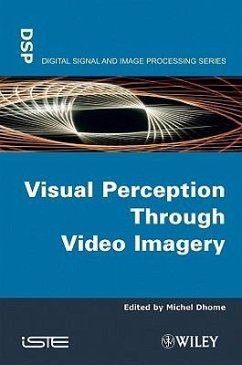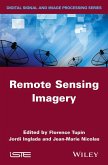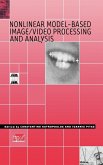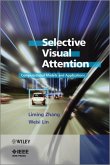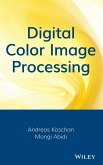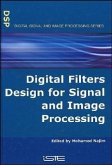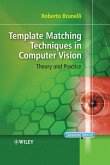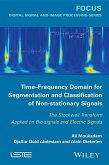Visual Perception Through Video Imagery
Herausgeber: Dhome, Michel
Visual Perception Through Video Imagery
Herausgeber: Dhome, Michel
- Gebundenes Buch
- Merkliste
- Auf die Merkliste
- Bewerten Bewerten
- Teilen
- Produkt teilen
- Produkterinnerung
- Produkterinnerung
For several decades researchers have tried to construct perception systems based on the registration data from video cameras. This work has produced various tools that have made recent advances possible in this area. Part 1 of this book deals with the problem of the calibration and auto-calibration of video captures. Part 2 is essentially concerned with the estimation of the relative object/capture position when a priori information is introduced (the CAD model of the object). Finally, Part 3 discusses the inference of density information and the shape recognition in images.
Andere Kunden interessierten sich auch für
![Remote Sensing Imagery Remote Sensing Imagery]() Remote Sensing Imagery194,99 €
Remote Sensing Imagery194,99 €![Nonlinear Model-Based Image/Video Processing and Analysis Nonlinear Model-Based Image/Video Processing and Analysis]() Nonlinear Model-Based Image/Video Processing and Analysis209,99 €
Nonlinear Model-Based Image/Video Processing and Analysis209,99 €![Selective Visual Attention Selective Visual Attention]() Liming ZhangSelective Visual Attention176,99 €
Liming ZhangSelective Visual Attention176,99 €![Digital Color Image Processing Digital Color Image Processing]() Andreas KoschanDigital Color Image Processing231,99 €
Andreas KoschanDigital Color Image Processing231,99 €![Digital Filters Design for Signal and Image Processing Digital Filters Design for Signal and Image Processing]() Digital Filters Design for Signal and Image Processing329,99 €
Digital Filters Design for Signal and Image Processing329,99 €![Template Matching Techniques in Computer Vision Template Matching Techniques in Computer Vision]() Roberto BrunelliTemplate Matching Techniques in Computer Vision146,99 €
Roberto BrunelliTemplate Matching Techniques in Computer Vision146,99 €![Time-Frequency Domain for Segmentation and Classification of Non-stationary Signals Time-Frequency Domain for Segmentation and Classification of Non-stationary Signals]() Ali MoukademTime-Frequency Domain for Segmentation and Classification of Non-stationary Signals186,99 €
Ali MoukademTime-Frequency Domain for Segmentation and Classification of Non-stationary Signals186,99 €-
-
-
For several decades researchers have tried to construct perception systems based on the registration data from video cameras. This work has produced various tools that have made recent advances possible in this area. Part 1 of this book deals with the problem of the calibration and auto-calibration of video captures. Part 2 is essentially concerned with the estimation of the relative object/capture position when a priori information is introduced (the CAD model of the object). Finally, Part 3 discusses the inference of density information and the shape recognition in images.
Hinweis: Dieser Artikel kann nur an eine deutsche Lieferadresse ausgeliefert werden.
Hinweis: Dieser Artikel kann nur an eine deutsche Lieferadresse ausgeliefert werden.
Produktdetails
- Produktdetails
- Verlag: Wiley
- Seitenzahl: 328
- Erscheinungstermin: 1. März 2009
- Englisch
- Abmessung: 234mm x 155mm x 23mm
- Gewicht: 590g
- ISBN-13: 9781848210165
- ISBN-10: 1848210167
- Artikelnr.: 25344514
- Herstellerkennzeichnung
- Libri GmbH
- Europaallee 1
- 36244 Bad Hersfeld
- gpsr@libri.de
- Verlag: Wiley
- Seitenzahl: 328
- Erscheinungstermin: 1. März 2009
- Englisch
- Abmessung: 234mm x 155mm x 23mm
- Gewicht: 590g
- ISBN-13: 9781848210165
- ISBN-10: 1848210167
- Artikelnr.: 25344514
- Herstellerkennzeichnung
- Libri GmbH
- Europaallee 1
- 36244 Bad Hersfeld
- gpsr@libri.de
Michel Dhome, is Research Director at the CNRS and is a Professor at the University of Clermont-Ferrand, France.
Introduction 13
Part 1 17
Chapter 1. Calibration of Vision Sensors 19
Jean-Marc LAVEST and Gérard RIVES
1.1. Introduction 19
1.2. General formulation of the problem of calibration 20
1.2.1. Formulation of the problem 20
1.2.1.1. Modeling the camera and lens: pin-hole model 22
1.2.1.2. Formation of images: perspective projection 22
1.2.1.3. Changing lens/camera reference point 23
1.2.1.4. Changing of the camera/image point 24
1.2.1.5. Changing of coordinates in the image plane 24
1.2.2. General expression 25
1.2.2.1. General formulation of the problem of calibration 27
1.3. Linear approach 27
1.3.1. Principle 27
1.3.2. Notes and comments 29
1.4. Non-linear photogrammetric approach 30
1.4.1. Mathematic model 31
1.4.2. Solving the problem 34
1.4.3. Multi-image calibration 35
1.4.4. Self-calibration by bundle adjustment 36
1.4.4.1. Redefinition of the problem 36
1.4.4.2. Estimation of redundancy 37
1.4.4.3. Solution for a near scale factor 37
1.4.4.4. Initial conditions 38
1.4.5. Precision calculation 38
1.5. Results of experimentation 39
1.5.1. Bundle adjustment for a traditional lens 39
1.5.1.1. Initial and experimental conditions 39
1.5.1.2. Sequence of classic images 40
1.5.2. Specific case of fish-eye lenses 42
1.5.2.1. Traditional criterion 43
1.5.2.2. Zero distortion at r0 43
1.5.2.3. Normalization of distortion coefficients 44
1.5.2.4. Experiments 45
1.5.3. Calibration of underwater cameras 48
1.5.3.1. Theoretical notes 48
1.5.3.2. Experiments .49
1.5.3.3. The material 49
1.5.3.4. Results in air 49
1.5.3.5. Calibration in water 50
1.5.3.6. Relation between the calibration in air and in water 53
1.5.4. Calibration of zooms 55
1.5.4.1. Recalling optical properties 55
1.5.4.2. Estimate of the principal point 56
1.5.4.3. Experiments 57
1.6. Bibliography 58
Chapter 2. Self-Calibration of Video Sensors 61
Rachid DERICHE
2.1. Introduction 61
2.2. Reminder and notation 64
2.3. Huang-Faugeras constraints and Trivedi's equations 66
2.3.1. Huang-Faugeras constraints 66
2.3.2. Trivedi's constraints 67
2.3.3. Discussion 68
2.4. Kruppa equations 68
2.4.1. Geometric derivation of Kruppa equations 68
2.4.2. An algebraic derivation of Kruppa equations 70
2.4.3. Simplified Kruppa equations 72
2.5. Implementation 74
2.5.1. The choice of initial conditions 74
2.5.2. Optimization 75
2.6. Experimental results 76
2.6.1. Estimation of angles and length ratios from images 77
2.6.2. Experiments with synthetic data 78
2.6.3. Experiments with real data 79
2.7. Conclusion 85
2.8. Acknowledgement 87
2.9. Bibliography 87
Chapter 3. Specific Displacements for Self-calibration 91
Diane LINGRAND, François GASPARD and Thierry VIÉVILLE
3.1. Introduction: interest to resort to specific movements 91
3.2. Modeling: parametrization of specific models 93
3.2.1. Specific projection models 93
3.2.2. Specifications of internal parameters of the camera 96
3.2.3. Taking into account specific displacements 97
3.2.4. Relation with specific properties in the scene 100
3.3. Self-calibration of a camera 100
3.3.1. Usage of pure rotations or points at the horizon 103
3.3.2. Pure rotation and fixed parameters 104
3.3.3. Rotation around a fixed axis 106
3.4. Perception of depth 108
3.4.1. Usage of pure translations 108
3.4.2. Retinal movements 111
3.4.3. Variation of the focal length 114
3.5. Estimating a specific model on real data 119
3.5.1. Application of the estimation mechanism to model inference 122
3.5.2. Some experimental results 123
3.5.3. Application at the localization of a plane 125
3.5.3.1. Rotation in pitch and calibration from a plane 130
3.6. Conclusion 136
3.7. Bibliography 136
Part 2 143
Chapter 4. Localization Tools 145
Michel DHOME and Jean-Thierry LAPRESTÉ
4.1. Introduction 145
4.2. Geometric modeling of a video camera 146
4.2.1. Pinhole model 146
4.2.2. Perspective projection of a 3D point 147
4.3. Localization of a voluminous object by monocular vision 148
4.3.1. Introduction 148
4.3.2. Mappings 149
4.3.2.1. Matching of lines 149
4.3.2.2. Pairing of points 150
4.3.3. Criterion to minimize 152
4.3.4. Solving the problem using the Newton-Raphson method 153
4.3.5. Calculation of partial derivatives 154
4.3.6. Results 156
4.4. Localization of a voluminous object by multi-ocular vision 158
4.4.1. Mathematical developments 158
4.4.2. Calculation of partial derivatives 159
4.4.3. Results 159
4.5. Localization of an articulated object 161
4.5.1. Mathematical development 161
4.5.2. Calculation of partial derivatives for intrinsic parameters 163
4.5.3. Results 163
4.6. Hand-eye calibration 164
4.6.1. Introduction 164
4.6.2. Presentation of the method 164
4.6.3. Geometric constraint 166
4.6.4. Results 166
4.7. Initialization methods 168
4.7.1. Initial hypotheses 168
4.7.2. Objective 169
4.7.3. Under the hypothesis of perspective projection 170
4.7.4. Under the hypothesis of scaled orthographic projection 172
4.7.5. Development of the algorithm 173
4.7.6. Specific case of a planar object 174
4.8. Analytical calculations of localization errors 177
4.8.1. Uncertainties in the estimation of a line equation 177
4.8.2. Errors in normals 179
4.8.3. Uncertainties in final localization of polyhedral objects 181
4.8.3.1. Covariance matrix associated with the localization parameters 181
4.9. Conclusion 183
4.10. Bibliography 183
Part 3 187
Chapter 5. Reconstruction of 3D Scenes from Multiple Views 189
Long QUAN, Luce MORIN and Lionel OISEL
5.1. Introduction 189
5.2. Geometry relating to the acquisition of multiple images 189
5.2.1. Geometry of two images 189
5.2.1.1. Geometric aspect 190
5.2.1.2. Algebraic aspect 191
5.2.1.3. Properties of F 191
5.2.1.4. Estimation of the fundamental matrix 192
5.2.1.7. Optimal algorithms 193
5.2.1.8. Robust algorithms which make it possible to eliminate false
pairing between a couple of points 194
5.2.2. Geometry of 3 images 195
5.2.3. Geometry beyond 3 images 199
5.3. Matching 200
5.3.1. State of the art elements 200
5.3.1.1. Correlation 201
5.3.1.2. Block-matching 202
5.3.1.3. Dynamic programming 202
5.3.1.4. Association of the optical flow and epipolar geometry 202
5.3.1.5. Energy modeling 204
5.3.2. Dense estimation algorithm based on optical flow 205
5.3.2.1. Hypothesis for the conservation of brightness 205
5.3.2.2. Energy modeling 206
5.3.2.3. Multi-resolution minimization diagram 207
5.4. 3D reconstruction 208
5.4.1. Reconstruction principle: retro-projection 209
5.4.2. Projective reconstruction 209
5.4.3. Euclidean reconstruction 212
5.4.3.1. Calibrated cameras 212
5.4.3.2. Known intrinsic parameters 212
5.4.3.3. Known metric data in the scene 213
5.5. 3D modeling 214
5.5.1. Implicit model 214
5.5.2. Point sets 216
5.5.3. Triangular mesh 216
5.5.3.1. Interactive designation of mesh vertices 217
5.5.3.2. Microfacets 217
5.5.3.3. Triangulation of the points of interest 217
5.5.3.4. Adaptive triangulation 217
5.5.3.5. Regular triangulation 219
5.6. Examples of applications 219
5.6.1. Virtual view rendering 219
5.6.2. VRML models 220
5.7. Conclusion 220
5.8. Bibliography 221
Chapter 6. 3D Reconstruction by Active Dynamic Vision 225
Éric MARCHAND and François CHAUMETTE
6.1. Introduction: active vision 225
6.2. Reconstruction of 3D primitives 227
6.2.1. Reconstruction by dynamic vision: a rapid state of the art 227
6.2.2. General principle 230
6.2.3. Some specific cases 232
6.2.3.1. Point 232
6.2.3.2. Line 233
6.2.3.3. Cylinder 235
6.2.4. 3D reconstruction by active vision 235
6.2.4.1. 3D reconstruction by active vision: state of the art 236
6.2.4.2. Optimal 3D reconstruction of a primitive 237
6.2.5. Generation of camera movements 240
6.3. Reconstruction of a complete scene 243
6.3.1. Automatic positioning of the camera for the observation of the scene
243
6.3.2. Scene reconstruction: general principle 244
6.3.3. Local focusing strategy 245
6.3.4. Completeness of reconstruction: selection of viewpoints 247
6.3.4.1. Calculation of new viewpoints 247
6.3.4.2. Optimization 250
6.4. Results 250
6.4.1. Reconstruction of 3D primitive: case of the cylinder 251
6.4.2. Perception strategies 252
6.4.2.1. Local exploration 252
6.4.2.2. Total exploration 254
6.5. Conclusion 257
6.6. Appendix: calculation of the interaction matrix 258
6.7. Bibliography 259
Part 4 263
Chapter 7. Shape Recognition in Images 265
Patrick GROS and Cordelia SCHMID
7.1. Introduction 265
7.2. State of the art 266
7.2.1. Searching images based on photometric data 266
7.2.2. Search for images based on geometric data 267
7.2.3. Recognition using a 3D geometric model 268
7.2.4. Recognition using a set of images 270
7.3. Principle of local quasi-invariants 270
7.4. Photometric approach 272
7.4.1. Key points 272
7.4.2. Differential invariants of gray levels 273
7.4.3. Comparison of descriptors with Mahalanobis distance 275
7.4.4. Voting algorithm 276
7.4.5. Semi-local constraints 277
7.4.6. Multi-dimensional indexing 278
7.4.7. Experimental results 279
7.4.8. Extensions 282
7.5. Geometric approach 284
7.5.1. Basic algorithm 284
7.5.2. Some results 285
7.5.2.1. Pairing results 285
7.5.2.2. Results of indexing and recognition 286
7.6. Indexing of images 288
7.6.1. Traditional approaches 290
7.6.2. VA-File and the Pyramid-Tree 291
7.6.3. Some results 292
7.6.3.1. Context of experiments 293
7.6.3.2. First experiment 293
7.6.3.3. Second experiment 293
7.6.3.4. Third experiment 294
7.6.4. Some prospects 294
7.7. Conclusion 295
7.8. Bibliography 296
List of Authors 301
Index 305
Part 1 17
Chapter 1. Calibration of Vision Sensors 19
Jean-Marc LAVEST and Gérard RIVES
1.1. Introduction 19
1.2. General formulation of the problem of calibration 20
1.2.1. Formulation of the problem 20
1.2.1.1. Modeling the camera and lens: pin-hole model 22
1.2.1.2. Formation of images: perspective projection 22
1.2.1.3. Changing lens/camera reference point 23
1.2.1.4. Changing of the camera/image point 24
1.2.1.5. Changing of coordinates in the image plane 24
1.2.2. General expression 25
1.2.2.1. General formulation of the problem of calibration 27
1.3. Linear approach 27
1.3.1. Principle 27
1.3.2. Notes and comments 29
1.4. Non-linear photogrammetric approach 30
1.4.1. Mathematic model 31
1.4.2. Solving the problem 34
1.4.3. Multi-image calibration 35
1.4.4. Self-calibration by bundle adjustment 36
1.4.4.1. Redefinition of the problem 36
1.4.4.2. Estimation of redundancy 37
1.4.4.3. Solution for a near scale factor 37
1.4.4.4. Initial conditions 38
1.4.5. Precision calculation 38
1.5. Results of experimentation 39
1.5.1. Bundle adjustment for a traditional lens 39
1.5.1.1. Initial and experimental conditions 39
1.5.1.2. Sequence of classic images 40
1.5.2. Specific case of fish-eye lenses 42
1.5.2.1. Traditional criterion 43
1.5.2.2. Zero distortion at r0 43
1.5.2.3. Normalization of distortion coefficients 44
1.5.2.4. Experiments 45
1.5.3. Calibration of underwater cameras 48
1.5.3.1. Theoretical notes 48
1.5.3.2. Experiments .49
1.5.3.3. The material 49
1.5.3.4. Results in air 49
1.5.3.5. Calibration in water 50
1.5.3.6. Relation between the calibration in air and in water 53
1.5.4. Calibration of zooms 55
1.5.4.1. Recalling optical properties 55
1.5.4.2. Estimate of the principal point 56
1.5.4.3. Experiments 57
1.6. Bibliography 58
Chapter 2. Self-Calibration of Video Sensors 61
Rachid DERICHE
2.1. Introduction 61
2.2. Reminder and notation 64
2.3. Huang-Faugeras constraints and Trivedi's equations 66
2.3.1. Huang-Faugeras constraints 66
2.3.2. Trivedi's constraints 67
2.3.3. Discussion 68
2.4. Kruppa equations 68
2.4.1. Geometric derivation of Kruppa equations 68
2.4.2. An algebraic derivation of Kruppa equations 70
2.4.3. Simplified Kruppa equations 72
2.5. Implementation 74
2.5.1. The choice of initial conditions 74
2.5.2. Optimization 75
2.6. Experimental results 76
2.6.1. Estimation of angles and length ratios from images 77
2.6.2. Experiments with synthetic data 78
2.6.3. Experiments with real data 79
2.7. Conclusion 85
2.8. Acknowledgement 87
2.9. Bibliography 87
Chapter 3. Specific Displacements for Self-calibration 91
Diane LINGRAND, François GASPARD and Thierry VIÉVILLE
3.1. Introduction: interest to resort to specific movements 91
3.2. Modeling: parametrization of specific models 93
3.2.1. Specific projection models 93
3.2.2. Specifications of internal parameters of the camera 96
3.2.3. Taking into account specific displacements 97
3.2.4. Relation with specific properties in the scene 100
3.3. Self-calibration of a camera 100
3.3.1. Usage of pure rotations or points at the horizon 103
3.3.2. Pure rotation and fixed parameters 104
3.3.3. Rotation around a fixed axis 106
3.4. Perception of depth 108
3.4.1. Usage of pure translations 108
3.4.2. Retinal movements 111
3.4.3. Variation of the focal length 114
3.5. Estimating a specific model on real data 119
3.5.1. Application of the estimation mechanism to model inference 122
3.5.2. Some experimental results 123
3.5.3. Application at the localization of a plane 125
3.5.3.1. Rotation in pitch and calibration from a plane 130
3.6. Conclusion 136
3.7. Bibliography 136
Part 2 143
Chapter 4. Localization Tools 145
Michel DHOME and Jean-Thierry LAPRESTÉ
4.1. Introduction 145
4.2. Geometric modeling of a video camera 146
4.2.1. Pinhole model 146
4.2.2. Perspective projection of a 3D point 147
4.3. Localization of a voluminous object by monocular vision 148
4.3.1. Introduction 148
4.3.2. Mappings 149
4.3.2.1. Matching of lines 149
4.3.2.2. Pairing of points 150
4.3.3. Criterion to minimize 152
4.3.4. Solving the problem using the Newton-Raphson method 153
4.3.5. Calculation of partial derivatives 154
4.3.6. Results 156
4.4. Localization of a voluminous object by multi-ocular vision 158
4.4.1. Mathematical developments 158
4.4.2. Calculation of partial derivatives 159
4.4.3. Results 159
4.5. Localization of an articulated object 161
4.5.1. Mathematical development 161
4.5.2. Calculation of partial derivatives for intrinsic parameters 163
4.5.3. Results 163
4.6. Hand-eye calibration 164
4.6.1. Introduction 164
4.6.2. Presentation of the method 164
4.6.3. Geometric constraint 166
4.6.4. Results 166
4.7. Initialization methods 168
4.7.1. Initial hypotheses 168
4.7.2. Objective 169
4.7.3. Under the hypothesis of perspective projection 170
4.7.4. Under the hypothesis of scaled orthographic projection 172
4.7.5. Development of the algorithm 173
4.7.6. Specific case of a planar object 174
4.8. Analytical calculations of localization errors 177
4.8.1. Uncertainties in the estimation of a line equation 177
4.8.2. Errors in normals 179
4.8.3. Uncertainties in final localization of polyhedral objects 181
4.8.3.1. Covariance matrix associated with the localization parameters 181
4.9. Conclusion 183
4.10. Bibliography 183
Part 3 187
Chapter 5. Reconstruction of 3D Scenes from Multiple Views 189
Long QUAN, Luce MORIN and Lionel OISEL
5.1. Introduction 189
5.2. Geometry relating to the acquisition of multiple images 189
5.2.1. Geometry of two images 189
5.2.1.1. Geometric aspect 190
5.2.1.2. Algebraic aspect 191
5.2.1.3. Properties of F 191
5.2.1.4. Estimation of the fundamental matrix 192
5.2.1.7. Optimal algorithms 193
5.2.1.8. Robust algorithms which make it possible to eliminate false
pairing between a couple of points 194
5.2.2. Geometry of 3 images 195
5.2.3. Geometry beyond 3 images 199
5.3. Matching 200
5.3.1. State of the art elements 200
5.3.1.1. Correlation 201
5.3.1.2. Block-matching 202
5.3.1.3. Dynamic programming 202
5.3.1.4. Association of the optical flow and epipolar geometry 202
5.3.1.5. Energy modeling 204
5.3.2. Dense estimation algorithm based on optical flow 205
5.3.2.1. Hypothesis for the conservation of brightness 205
5.3.2.2. Energy modeling 206
5.3.2.3. Multi-resolution minimization diagram 207
5.4. 3D reconstruction 208
5.4.1. Reconstruction principle: retro-projection 209
5.4.2. Projective reconstruction 209
5.4.3. Euclidean reconstruction 212
5.4.3.1. Calibrated cameras 212
5.4.3.2. Known intrinsic parameters 212
5.4.3.3. Known metric data in the scene 213
5.5. 3D modeling 214
5.5.1. Implicit model 214
5.5.2. Point sets 216
5.5.3. Triangular mesh 216
5.5.3.1. Interactive designation of mesh vertices 217
5.5.3.2. Microfacets 217
5.5.3.3. Triangulation of the points of interest 217
5.5.3.4. Adaptive triangulation 217
5.5.3.5. Regular triangulation 219
5.6. Examples of applications 219
5.6.1. Virtual view rendering 219
5.6.2. VRML models 220
5.7. Conclusion 220
5.8. Bibliography 221
Chapter 6. 3D Reconstruction by Active Dynamic Vision 225
Éric MARCHAND and François CHAUMETTE
6.1. Introduction: active vision 225
6.2. Reconstruction of 3D primitives 227
6.2.1. Reconstruction by dynamic vision: a rapid state of the art 227
6.2.2. General principle 230
6.2.3. Some specific cases 232
6.2.3.1. Point 232
6.2.3.2. Line 233
6.2.3.3. Cylinder 235
6.2.4. 3D reconstruction by active vision 235
6.2.4.1. 3D reconstruction by active vision: state of the art 236
6.2.4.2. Optimal 3D reconstruction of a primitive 237
6.2.5. Generation of camera movements 240
6.3. Reconstruction of a complete scene 243
6.3.1. Automatic positioning of the camera for the observation of the scene
243
6.3.2. Scene reconstruction: general principle 244
6.3.3. Local focusing strategy 245
6.3.4. Completeness of reconstruction: selection of viewpoints 247
6.3.4.1. Calculation of new viewpoints 247
6.3.4.2. Optimization 250
6.4. Results 250
6.4.1. Reconstruction of 3D primitive: case of the cylinder 251
6.4.2. Perception strategies 252
6.4.2.1. Local exploration 252
6.4.2.2. Total exploration 254
6.5. Conclusion 257
6.6. Appendix: calculation of the interaction matrix 258
6.7. Bibliography 259
Part 4 263
Chapter 7. Shape Recognition in Images 265
Patrick GROS and Cordelia SCHMID
7.1. Introduction 265
7.2. State of the art 266
7.2.1. Searching images based on photometric data 266
7.2.2. Search for images based on geometric data 267
7.2.3. Recognition using a 3D geometric model 268
7.2.4. Recognition using a set of images 270
7.3. Principle of local quasi-invariants 270
7.4. Photometric approach 272
7.4.1. Key points 272
7.4.2. Differential invariants of gray levels 273
7.4.3. Comparison of descriptors with Mahalanobis distance 275
7.4.4. Voting algorithm 276
7.4.5. Semi-local constraints 277
7.4.6. Multi-dimensional indexing 278
7.4.7. Experimental results 279
7.4.8. Extensions 282
7.5. Geometric approach 284
7.5.1. Basic algorithm 284
7.5.2. Some results 285
7.5.2.1. Pairing results 285
7.5.2.2. Results of indexing and recognition 286
7.6. Indexing of images 288
7.6.1. Traditional approaches 290
7.6.2. VA-File and the Pyramid-Tree 291
7.6.3. Some results 292
7.6.3.1. Context of experiments 293
7.6.3.2. First experiment 293
7.6.3.3. Second experiment 293
7.6.3.4. Third experiment 294
7.6.4. Some prospects 294
7.7. Conclusion 295
7.8. Bibliography 296
List of Authors 301
Index 305
Introduction 13
Part 1 17
Chapter 1. Calibration of Vision Sensors 19
Jean-Marc LAVEST and Gérard RIVES
1.1. Introduction 19
1.2. General formulation of the problem of calibration 20
1.2.1. Formulation of the problem 20
1.2.1.1. Modeling the camera and lens: pin-hole model 22
1.2.1.2. Formation of images: perspective projection 22
1.2.1.3. Changing lens/camera reference point 23
1.2.1.4. Changing of the camera/image point 24
1.2.1.5. Changing of coordinates in the image plane 24
1.2.2. General expression 25
1.2.2.1. General formulation of the problem of calibration 27
1.3. Linear approach 27
1.3.1. Principle 27
1.3.2. Notes and comments 29
1.4. Non-linear photogrammetric approach 30
1.4.1. Mathematic model 31
1.4.2. Solving the problem 34
1.4.3. Multi-image calibration 35
1.4.4. Self-calibration by bundle adjustment 36
1.4.4.1. Redefinition of the problem 36
1.4.4.2. Estimation of redundancy 37
1.4.4.3. Solution for a near scale factor 37
1.4.4.4. Initial conditions 38
1.4.5. Precision calculation 38
1.5. Results of experimentation 39
1.5.1. Bundle adjustment for a traditional lens 39
1.5.1.1. Initial and experimental conditions 39
1.5.1.2. Sequence of classic images 40
1.5.2. Specific case of fish-eye lenses 42
1.5.2.1. Traditional criterion 43
1.5.2.2. Zero distortion at r0 43
1.5.2.3. Normalization of distortion coefficients 44
1.5.2.4. Experiments 45
1.5.3. Calibration of underwater cameras 48
1.5.3.1. Theoretical notes 48
1.5.3.2. Experiments .49
1.5.3.3. The material 49
1.5.3.4. Results in air 49
1.5.3.5. Calibration in water 50
1.5.3.6. Relation between the calibration in air and in water 53
1.5.4. Calibration of zooms 55
1.5.4.1. Recalling optical properties 55
1.5.4.2. Estimate of the principal point 56
1.5.4.3. Experiments 57
1.6. Bibliography 58
Chapter 2. Self-Calibration of Video Sensors 61
Rachid DERICHE
2.1. Introduction 61
2.2. Reminder and notation 64
2.3. Huang-Faugeras constraints and Trivedi's equations 66
2.3.1. Huang-Faugeras constraints 66
2.3.2. Trivedi's constraints 67
2.3.3. Discussion 68
2.4. Kruppa equations 68
2.4.1. Geometric derivation of Kruppa equations 68
2.4.2. An algebraic derivation of Kruppa equations 70
2.4.3. Simplified Kruppa equations 72
2.5. Implementation 74
2.5.1. The choice of initial conditions 74
2.5.2. Optimization 75
2.6. Experimental results 76
2.6.1. Estimation of angles and length ratios from images 77
2.6.2. Experiments with synthetic data 78
2.6.3. Experiments with real data 79
2.7. Conclusion 85
2.8. Acknowledgement 87
2.9. Bibliography 87
Chapter 3. Specific Displacements for Self-calibration 91
Diane LINGRAND, François GASPARD and Thierry VIÉVILLE
3.1. Introduction: interest to resort to specific movements 91
3.2. Modeling: parametrization of specific models 93
3.2.1. Specific projection models 93
3.2.2. Specifications of internal parameters of the camera 96
3.2.3. Taking into account specific displacements 97
3.2.4. Relation with specific properties in the scene 100
3.3. Self-calibration of a camera 100
3.3.1. Usage of pure rotations or points at the horizon 103
3.3.2. Pure rotation and fixed parameters 104
3.3.3. Rotation around a fixed axis 106
3.4. Perception of depth 108
3.4.1. Usage of pure translations 108
3.4.2. Retinal movements 111
3.4.3. Variation of the focal length 114
3.5. Estimating a specific model on real data 119
3.5.1. Application of the estimation mechanism to model inference 122
3.5.2. Some experimental results 123
3.5.3. Application at the localization of a plane 125
3.5.3.1. Rotation in pitch and calibration from a plane 130
3.6. Conclusion 136
3.7. Bibliography 136
Part 2 143
Chapter 4. Localization Tools 145
Michel DHOME and Jean-Thierry LAPRESTÉ
4.1. Introduction 145
4.2. Geometric modeling of a video camera 146
4.2.1. Pinhole model 146
4.2.2. Perspective projection of a 3D point 147
4.3. Localization of a voluminous object by monocular vision 148
4.3.1. Introduction 148
4.3.2. Mappings 149
4.3.2.1. Matching of lines 149
4.3.2.2. Pairing of points 150
4.3.3. Criterion to minimize 152
4.3.4. Solving the problem using the Newton-Raphson method 153
4.3.5. Calculation of partial derivatives 154
4.3.6. Results 156
4.4. Localization of a voluminous object by multi-ocular vision 158
4.4.1. Mathematical developments 158
4.4.2. Calculation of partial derivatives 159
4.4.3. Results 159
4.5. Localization of an articulated object 161
4.5.1. Mathematical development 161
4.5.2. Calculation of partial derivatives for intrinsic parameters 163
4.5.3. Results 163
4.6. Hand-eye calibration 164
4.6.1. Introduction 164
4.6.2. Presentation of the method 164
4.6.3. Geometric constraint 166
4.6.4. Results 166
4.7. Initialization methods 168
4.7.1. Initial hypotheses 168
4.7.2. Objective 169
4.7.3. Under the hypothesis of perspective projection 170
4.7.4. Under the hypothesis of scaled orthographic projection 172
4.7.5. Development of the algorithm 173
4.7.6. Specific case of a planar object 174
4.8. Analytical calculations of localization errors 177
4.8.1. Uncertainties in the estimation of a line equation 177
4.8.2. Errors in normals 179
4.8.3. Uncertainties in final localization of polyhedral objects 181
4.8.3.1. Covariance matrix associated with the localization parameters 181
4.9. Conclusion 183
4.10. Bibliography 183
Part 3 187
Chapter 5. Reconstruction of 3D Scenes from Multiple Views 189
Long QUAN, Luce MORIN and Lionel OISEL
5.1. Introduction 189
5.2. Geometry relating to the acquisition of multiple images 189
5.2.1. Geometry of two images 189
5.2.1.1. Geometric aspect 190
5.2.1.2. Algebraic aspect 191
5.2.1.3. Properties of F 191
5.2.1.4. Estimation of the fundamental matrix 192
5.2.1.7. Optimal algorithms 193
5.2.1.8. Robust algorithms which make it possible to eliminate false
pairing between a couple of points 194
5.2.2. Geometry of 3 images 195
5.2.3. Geometry beyond 3 images 199
5.3. Matching 200
5.3.1. State of the art elements 200
5.3.1.1. Correlation 201
5.3.1.2. Block-matching 202
5.3.1.3. Dynamic programming 202
5.3.1.4. Association of the optical flow and epipolar geometry 202
5.3.1.5. Energy modeling 204
5.3.2. Dense estimation algorithm based on optical flow 205
5.3.2.1. Hypothesis for the conservation of brightness 205
5.3.2.2. Energy modeling 206
5.3.2.3. Multi-resolution minimization diagram 207
5.4. 3D reconstruction 208
5.4.1. Reconstruction principle: retro-projection 209
5.4.2. Projective reconstruction 209
5.4.3. Euclidean reconstruction 212
5.4.3.1. Calibrated cameras 212
5.4.3.2. Known intrinsic parameters 212
5.4.3.3. Known metric data in the scene 213
5.5. 3D modeling 214
5.5.1. Implicit model 214
5.5.2. Point sets 216
5.5.3. Triangular mesh 216
5.5.3.1. Interactive designation of mesh vertices 217
5.5.3.2. Microfacets 217
5.5.3.3. Triangulation of the points of interest 217
5.5.3.4. Adaptive triangulation 217
5.5.3.5. Regular triangulation 219
5.6. Examples of applications 219
5.6.1. Virtual view rendering 219
5.6.2. VRML models 220
5.7. Conclusion 220
5.8. Bibliography 221
Chapter 6. 3D Reconstruction by Active Dynamic Vision 225
Éric MARCHAND and François CHAUMETTE
6.1. Introduction: active vision 225
6.2. Reconstruction of 3D primitives 227
6.2.1. Reconstruction by dynamic vision: a rapid state of the art 227
6.2.2. General principle 230
6.2.3. Some specific cases 232
6.2.3.1. Point 232
6.2.3.2. Line 233
6.2.3.3. Cylinder 235
6.2.4. 3D reconstruction by active vision 235
6.2.4.1. 3D reconstruction by active vision: state of the art 236
6.2.4.2. Optimal 3D reconstruction of a primitive 237
6.2.5. Generation of camera movements 240
6.3. Reconstruction of a complete scene 243
6.3.1. Automatic positioning of the camera for the observation of the scene
243
6.3.2. Scene reconstruction: general principle 244
6.3.3. Local focusing strategy 245
6.3.4. Completeness of reconstruction: selection of viewpoints 247
6.3.4.1. Calculation of new viewpoints 247
6.3.4.2. Optimization 250
6.4. Results 250
6.4.1. Reconstruction of 3D primitive: case of the cylinder 251
6.4.2. Perception strategies 252
6.4.2.1. Local exploration 252
6.4.2.2. Total exploration 254
6.5. Conclusion 257
6.6. Appendix: calculation of the interaction matrix 258
6.7. Bibliography 259
Part 4 263
Chapter 7. Shape Recognition in Images 265
Patrick GROS and Cordelia SCHMID
7.1. Introduction 265
7.2. State of the art 266
7.2.1. Searching images based on photometric data 266
7.2.2. Search for images based on geometric data 267
7.2.3. Recognition using a 3D geometric model 268
7.2.4. Recognition using a set of images 270
7.3. Principle of local quasi-invariants 270
7.4. Photometric approach 272
7.4.1. Key points 272
7.4.2. Differential invariants of gray levels 273
7.4.3. Comparison of descriptors with Mahalanobis distance 275
7.4.4. Voting algorithm 276
7.4.5. Semi-local constraints 277
7.4.6. Multi-dimensional indexing 278
7.4.7. Experimental results 279
7.4.8. Extensions 282
7.5. Geometric approach 284
7.5.1. Basic algorithm 284
7.5.2. Some results 285
7.5.2.1. Pairing results 285
7.5.2.2. Results of indexing and recognition 286
7.6. Indexing of images 288
7.6.1. Traditional approaches 290
7.6.2. VA-File and the Pyramid-Tree 291
7.6.3. Some results 292
7.6.3.1. Context of experiments 293
7.6.3.2. First experiment 293
7.6.3.3. Second experiment 293
7.6.3.4. Third experiment 294
7.6.4. Some prospects 294
7.7. Conclusion 295
7.8. Bibliography 296
List of Authors 301
Index 305
Part 1 17
Chapter 1. Calibration of Vision Sensors 19
Jean-Marc LAVEST and Gérard RIVES
1.1. Introduction 19
1.2. General formulation of the problem of calibration 20
1.2.1. Formulation of the problem 20
1.2.1.1. Modeling the camera and lens: pin-hole model 22
1.2.1.2. Formation of images: perspective projection 22
1.2.1.3. Changing lens/camera reference point 23
1.2.1.4. Changing of the camera/image point 24
1.2.1.5. Changing of coordinates in the image plane 24
1.2.2. General expression 25
1.2.2.1. General formulation of the problem of calibration 27
1.3. Linear approach 27
1.3.1. Principle 27
1.3.2. Notes and comments 29
1.4. Non-linear photogrammetric approach 30
1.4.1. Mathematic model 31
1.4.2. Solving the problem 34
1.4.3. Multi-image calibration 35
1.4.4. Self-calibration by bundle adjustment 36
1.4.4.1. Redefinition of the problem 36
1.4.4.2. Estimation of redundancy 37
1.4.4.3. Solution for a near scale factor 37
1.4.4.4. Initial conditions 38
1.4.5. Precision calculation 38
1.5. Results of experimentation 39
1.5.1. Bundle adjustment for a traditional lens 39
1.5.1.1. Initial and experimental conditions 39
1.5.1.2. Sequence of classic images 40
1.5.2. Specific case of fish-eye lenses 42
1.5.2.1. Traditional criterion 43
1.5.2.2. Zero distortion at r0 43
1.5.2.3. Normalization of distortion coefficients 44
1.5.2.4. Experiments 45
1.5.3. Calibration of underwater cameras 48
1.5.3.1. Theoretical notes 48
1.5.3.2. Experiments .49
1.5.3.3. The material 49
1.5.3.4. Results in air 49
1.5.3.5. Calibration in water 50
1.5.3.6. Relation between the calibration in air and in water 53
1.5.4. Calibration of zooms 55
1.5.4.1. Recalling optical properties 55
1.5.4.2. Estimate of the principal point 56
1.5.4.3. Experiments 57
1.6. Bibliography 58
Chapter 2. Self-Calibration of Video Sensors 61
Rachid DERICHE
2.1. Introduction 61
2.2. Reminder and notation 64
2.3. Huang-Faugeras constraints and Trivedi's equations 66
2.3.1. Huang-Faugeras constraints 66
2.3.2. Trivedi's constraints 67
2.3.3. Discussion 68
2.4. Kruppa equations 68
2.4.1. Geometric derivation of Kruppa equations 68
2.4.2. An algebraic derivation of Kruppa equations 70
2.4.3. Simplified Kruppa equations 72
2.5. Implementation 74
2.5.1. The choice of initial conditions 74
2.5.2. Optimization 75
2.6. Experimental results 76
2.6.1. Estimation of angles and length ratios from images 77
2.6.2. Experiments with synthetic data 78
2.6.3. Experiments with real data 79
2.7. Conclusion 85
2.8. Acknowledgement 87
2.9. Bibliography 87
Chapter 3. Specific Displacements for Self-calibration 91
Diane LINGRAND, François GASPARD and Thierry VIÉVILLE
3.1. Introduction: interest to resort to specific movements 91
3.2. Modeling: parametrization of specific models 93
3.2.1. Specific projection models 93
3.2.2. Specifications of internal parameters of the camera 96
3.2.3. Taking into account specific displacements 97
3.2.4. Relation with specific properties in the scene 100
3.3. Self-calibration of a camera 100
3.3.1. Usage of pure rotations or points at the horizon 103
3.3.2. Pure rotation and fixed parameters 104
3.3.3. Rotation around a fixed axis 106
3.4. Perception of depth 108
3.4.1. Usage of pure translations 108
3.4.2. Retinal movements 111
3.4.3. Variation of the focal length 114
3.5. Estimating a specific model on real data 119
3.5.1. Application of the estimation mechanism to model inference 122
3.5.2. Some experimental results 123
3.5.3. Application at the localization of a plane 125
3.5.3.1. Rotation in pitch and calibration from a plane 130
3.6. Conclusion 136
3.7. Bibliography 136
Part 2 143
Chapter 4. Localization Tools 145
Michel DHOME and Jean-Thierry LAPRESTÉ
4.1. Introduction 145
4.2. Geometric modeling of a video camera 146
4.2.1. Pinhole model 146
4.2.2. Perspective projection of a 3D point 147
4.3. Localization of a voluminous object by monocular vision 148
4.3.1. Introduction 148
4.3.2. Mappings 149
4.3.2.1. Matching of lines 149
4.3.2.2. Pairing of points 150
4.3.3. Criterion to minimize 152
4.3.4. Solving the problem using the Newton-Raphson method 153
4.3.5. Calculation of partial derivatives 154
4.3.6. Results 156
4.4. Localization of a voluminous object by multi-ocular vision 158
4.4.1. Mathematical developments 158
4.4.2. Calculation of partial derivatives 159
4.4.3. Results 159
4.5. Localization of an articulated object 161
4.5.1. Mathematical development 161
4.5.2. Calculation of partial derivatives for intrinsic parameters 163
4.5.3. Results 163
4.6. Hand-eye calibration 164
4.6.1. Introduction 164
4.6.2. Presentation of the method 164
4.6.3. Geometric constraint 166
4.6.4. Results 166
4.7. Initialization methods 168
4.7.1. Initial hypotheses 168
4.7.2. Objective 169
4.7.3. Under the hypothesis of perspective projection 170
4.7.4. Under the hypothesis of scaled orthographic projection 172
4.7.5. Development of the algorithm 173
4.7.6. Specific case of a planar object 174
4.8. Analytical calculations of localization errors 177
4.8.1. Uncertainties in the estimation of a line equation 177
4.8.2. Errors in normals 179
4.8.3. Uncertainties in final localization of polyhedral objects 181
4.8.3.1. Covariance matrix associated with the localization parameters 181
4.9. Conclusion 183
4.10. Bibliography 183
Part 3 187
Chapter 5. Reconstruction of 3D Scenes from Multiple Views 189
Long QUAN, Luce MORIN and Lionel OISEL
5.1. Introduction 189
5.2. Geometry relating to the acquisition of multiple images 189
5.2.1. Geometry of two images 189
5.2.1.1. Geometric aspect 190
5.2.1.2. Algebraic aspect 191
5.2.1.3. Properties of F 191
5.2.1.4. Estimation of the fundamental matrix 192
5.2.1.7. Optimal algorithms 193
5.2.1.8. Robust algorithms which make it possible to eliminate false
pairing between a couple of points 194
5.2.2. Geometry of 3 images 195
5.2.3. Geometry beyond 3 images 199
5.3. Matching 200
5.3.1. State of the art elements 200
5.3.1.1. Correlation 201
5.3.1.2. Block-matching 202
5.3.1.3. Dynamic programming 202
5.3.1.4. Association of the optical flow and epipolar geometry 202
5.3.1.5. Energy modeling 204
5.3.2. Dense estimation algorithm based on optical flow 205
5.3.2.1. Hypothesis for the conservation of brightness 205
5.3.2.2. Energy modeling 206
5.3.2.3. Multi-resolution minimization diagram 207
5.4. 3D reconstruction 208
5.4.1. Reconstruction principle: retro-projection 209
5.4.2. Projective reconstruction 209
5.4.3. Euclidean reconstruction 212
5.4.3.1. Calibrated cameras 212
5.4.3.2. Known intrinsic parameters 212
5.4.3.3. Known metric data in the scene 213
5.5. 3D modeling 214
5.5.1. Implicit model 214
5.5.2. Point sets 216
5.5.3. Triangular mesh 216
5.5.3.1. Interactive designation of mesh vertices 217
5.5.3.2. Microfacets 217
5.5.3.3. Triangulation of the points of interest 217
5.5.3.4. Adaptive triangulation 217
5.5.3.5. Regular triangulation 219
5.6. Examples of applications 219
5.6.1. Virtual view rendering 219
5.6.2. VRML models 220
5.7. Conclusion 220
5.8. Bibliography 221
Chapter 6. 3D Reconstruction by Active Dynamic Vision 225
Éric MARCHAND and François CHAUMETTE
6.1. Introduction: active vision 225
6.2. Reconstruction of 3D primitives 227
6.2.1. Reconstruction by dynamic vision: a rapid state of the art 227
6.2.2. General principle 230
6.2.3. Some specific cases 232
6.2.3.1. Point 232
6.2.3.2. Line 233
6.2.3.3. Cylinder 235
6.2.4. 3D reconstruction by active vision 235
6.2.4.1. 3D reconstruction by active vision: state of the art 236
6.2.4.2. Optimal 3D reconstruction of a primitive 237
6.2.5. Generation of camera movements 240
6.3. Reconstruction of a complete scene 243
6.3.1. Automatic positioning of the camera for the observation of the scene
243
6.3.2. Scene reconstruction: general principle 244
6.3.3. Local focusing strategy 245
6.3.4. Completeness of reconstruction: selection of viewpoints 247
6.3.4.1. Calculation of new viewpoints 247
6.3.4.2. Optimization 250
6.4. Results 250
6.4.1. Reconstruction of 3D primitive: case of the cylinder 251
6.4.2. Perception strategies 252
6.4.2.1. Local exploration 252
6.4.2.2. Total exploration 254
6.5. Conclusion 257
6.6. Appendix: calculation of the interaction matrix 258
6.7. Bibliography 259
Part 4 263
Chapter 7. Shape Recognition in Images 265
Patrick GROS and Cordelia SCHMID
7.1. Introduction 265
7.2. State of the art 266
7.2.1. Searching images based on photometric data 266
7.2.2. Search for images based on geometric data 267
7.2.3. Recognition using a 3D geometric model 268
7.2.4. Recognition using a set of images 270
7.3. Principle of local quasi-invariants 270
7.4. Photometric approach 272
7.4.1. Key points 272
7.4.2. Differential invariants of gray levels 273
7.4.3. Comparison of descriptors with Mahalanobis distance 275
7.4.4. Voting algorithm 276
7.4.5. Semi-local constraints 277
7.4.6. Multi-dimensional indexing 278
7.4.7. Experimental results 279
7.4.8. Extensions 282
7.5. Geometric approach 284
7.5.1. Basic algorithm 284
7.5.2. Some results 285
7.5.2.1. Pairing results 285
7.5.2.2. Results of indexing and recognition 286
7.6. Indexing of images 288
7.6.1. Traditional approaches 290
7.6.2. VA-File and the Pyramid-Tree 291
7.6.3. Some results 292
7.6.3.1. Context of experiments 293
7.6.3.2. First experiment 293
7.6.3.3. Second experiment 293
7.6.3.4. Third experiment 294
7.6.4. Some prospects 294
7.7. Conclusion 295
7.8. Bibliography 296
List of Authors 301
Index 305

